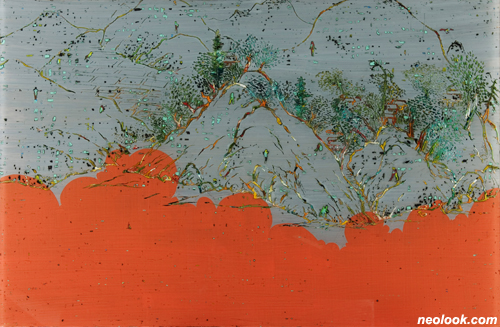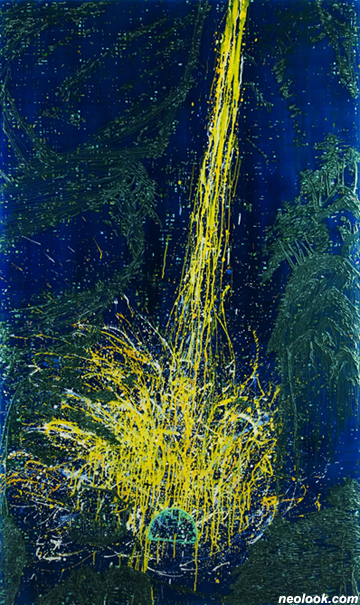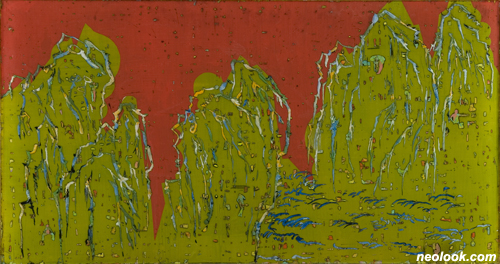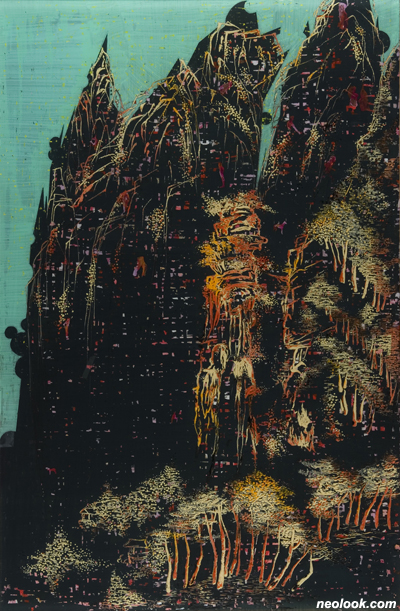- ● homepage
- ● archives
- ● restoration
- ● books
- ● big banners
- ● post board
- ■ neo's search
- ■ about us
- ■ 게재방법 안내
- 개인정보처리방침

- [email protected]
- Tel. 02_335_7922
- Fax. 02_335_7929
- 10:00am~04:30pm
- 월요일~금요일
- 3/3(월) 대체공휴일

Back to the Present
임희성展 / YIMHEESEONG / 林希星 / painting 2009_1111 ▶ 2009_1117
초대일시_2009_1111_수요일_06:00pm
관람시간 / 10:30am~06:30pm
관훈갤러리_KWANHOON gallery 서울 종로구 관훈동 195번지 Tel. +82.2.733.6469 www.kwanhoongallery.com
나의 붓은 드릴이고, 나의 종이는 아크릴 보드이다. (임희성) ● 정감 있는 한국적인 현대 산수도 한국 미술 문화를 배경으로 하는 예술은, 그것이 비록 순간적ㆍ우연적인 것이라 할지라도 보르레르(C.Baudelaire)의 이론에 비추어 본다면 영원한 예술성과 더불어 순수한 예술적 가치를 지니고 있다. 또한 심미적ㆍ상징적인 측면에서 한국적인 의미와 예술적인 특성들을 공유하고 있기 때문에 지역성도 극복할 수가 있다.

- 임희성_Back to the Present-千佛峰_아크릴 합성수지에 유채_130×85cm_2009_부분
작가 임희성은 한국의 전통 산수를 우리 시대의 삶과 정신이 담긴 그림으로 승화시키는 데 최선을 다하고 있다. 한국인의 삶과 혼이 들어있는 수묵을 현대적인 시각에서 재해석하는 데 주력하고 있는 것이다. 현대 한국의 산수도를 작가 나름의 시각으로 펼쳐 보이면서 정선의 산수 그림이나 김홍도의 그림 등에서 느껴지는 한국인의 정기와 삶의 모습을 미적으로 재인식시키는 실험성 짙은 작업이라 하겠다. 전통적인 그림에서 볼 수 있는 선 하나라도 소홀함 없이 이를 현대적으로 승화시키고자 하는 작가의 의지는 주목할 만하다. ● 아크릴(Acrylic plastic)을 주로 사용하여 전통 화선지가 지니는 특성을 새롭게 변형시키는 작가의 작업은 청년 작가다운 독창성과 실험성이 돋보인다. 이 독창성과 실험성은 단순하게 시도하는 차원을 넘어 작품의 완성도 면에서도 관심을 끈다. 드릴을 전통 붓으로 삼고 아크릴을 화선지로 삼아 그 위에 그려지는 여러 형태의 산수 그림은 오늘을 사는 우리 한국인들의 산과 자연에 대한 의미를 새롭게 인식시켜 주기도 한다. 드릴 날로 깎아 색을 밀어 넣은 선은 평면 안에서 독특한 붓놀림이 되며, 입체감이 느껴지는 작가만의 준(皴)을 형성한다. 조각칼로 일일이 깎아 만든 색은 어떠한 형이 있는 것처럼 보이며 그 안에 현대의 미감을 숨기고 있다.

- 임희성_Back to the Present-渼糊_아크릴 합성수지에 유채_85×130cm_2009

- 임희성_Back to the Present-朴淵瀑圖_아크릴 합성수지에 유채_200×120cm_2009

- 임희성_Back to the Present-麥坂_아크릴합성수지에 유채, 야외풍경연출_85×130cm_2009

- 임희성_Back to the Present-片舟渡海_아크릴 합성수지에 유채l_45×85cm_2009
전통 산수화는 시대적인 차이 때문에 충분하게 공감하지 못하는 면이 있지만, 전통성을 바탕으로 자신의 시각에서 이를 현대적으로 극대화하고자 많은 노력을 하고 있는 임희성의 작업은 우리 시대에 많은 공감을 불러일으킬 수 있다. 겸재 정선의 <박연폭포>를 보며 선조의 위대한 회화를 실감한 임희성은 담담하고 깊은 맛을 지닌 우리의 전통산수화를 많은 사람들과 함께 느껴보고 싶었던 것이다. 작가는 우리 시대의 산과 물의 소중함을 간직하고, 산은 공간성을, 물은 시간성을 의미한다고 여기며, 이를 전통 산수화의 형식을 빌려 생동감 있게 표현하고자 한다. ● 이제 작가가 추구하고자 하는, 아크릴을 이용한 산수 그림은 보다 많은 사람들의 공감을 불러일으킬 것이다. 젊은 청년 작가답게 의욕적으로 펼쳐 보이는, 우리의 산수를 바탕으로 한 전통 산수화의 재해석은 참신하다고 할 수 있다. 이번 전시를 계기로 보다 훌륭한 작품성을 갖게 되리라는 기대를 해본다. ■ 장준석

- 임희성_Back to the Present-佛頂臺_아크릴합성수지에 유채_130×85cm_2009
An Atmospheric Korean-style Modern Landscape Painting ● According to the theory of C. Baudelaire, the art of which background is Korean painting bears eternal artistry and pure artistic value, regardless of whether it is momentary or incidental. In addition, since it has Korean-style meanings and artistic characteristics in an aesthetic and symbolic sense, it can overcome a regional restriction. ● Artist Im Hi-seong makes every effort to sublimate Korean traditional landscape painting to such a picture which contains contemporary life and spirit. He seems to exert every effort to reinterpret an ink-and-wash painting which contains Koreans' life and spirit from the aspect of modern people. His paintings are seemingly experimental ones which express Korean-style landscapes with his own unique perspectives and aesthetically re-recognize Koreans' spiritual energy and life-style which can be felt from Jeong Seon's landscape paintings or Kim Hong-do's artistic works. It is remarkable that he tries not to neglect but to sublimate even a mere line, which can be seen in a traditional painting, to a modernistic level. ● His works of which main material is acrylic plastic change the characteristics of traditional drawing paper and are remarkable with young artist's creativity and experimentalism. His creativity and experimentalism do not remain in a mere attempt but go forward its completion. Using a drill as a traditional brush and acrylic plastic as drawing paper, he draws diverse patterns of landscape painting, thus making us re-recognize the meaning of Korean mountains and nature. The line made by the blade of a drill and inserted colors presents a unique touch of a brush in a plane and forms the artist's unique frame which has cubic effect. The colors made by a chisel one by one seem to have a certain pattern and hide a modern sense of aesthetics in it. ● A series of painting works, attempted by Im Hi-seong in the proposition of 「Back to the Present」, is expressed in a different angle from a traditional landscape painting. But his reinterpretation of images of traditional landscape paintings which he wants to present in this exhibition has its unique meaning and seems to be successful to some extent. The meaning seems to be the artist's mentality and plasticity, which he has had in his mind so far for traditional landscape paintings and which is newly interpreted from the aspect of modern people's everyday lives and veins in a material and technical sense. Namely, the landscape and nature on a transparent acrylic plate, which is presented in a new technique of expression that is different from traditional one, is the one made by a completely different perspective from our conception of conventional landscape paintings. For example, the other side of landscape painting on an acrylic plate, which uses a variety of colors, carries the trace of a drill which is similar to a traditional Korean landscape painting frame. This is the same with the distribution of colors, one of traditional techniques of a figure painting. Being added with a variety of colors, a landscape painting, which is overflowed with a variety of colorful and multi-formational modernistic senses of aesthetics, comes to exist via an image we couldn't anticipate. ● When based on age, a traditional landscape painting seems to be an old person, but the artist's landscape painting is a young one. Thus, it is interesting to see the fact that traditional landscape paintings are reinterpreted by a contemporary young artist from a new perspective. Different from the traditional landscape painting we have been accustomed to so far, a moderate topography and small and big mountains present a panoramic view of gorgeous and colorful spectrum, thus splendidly being on the stage again. The tendency of reinterpreting the traditional landscape painting is a recent phenomenon appeared in some young artists' works and has its own meaning. ● As is generally known, an ink-and-wash painting of which background is mountains and waters is one of representative Oriental painting media and bears a variety of painting techniques and genres as a central Korean painting. In addition, from the aspect of historical flow of art culture by and large, an ink-and-wash painting is an important axle of Korean painting and placed in the center of Korean art. It also has an inseparable relation with the modern painting and therefore it is seemingly one of noticeable Korean paintings. ● It is not only because thinking, behavior and cultural homogeneity are cross-linked in an ink-and-wash painting but because an implied conformity is extracted from it. Playing a great role for it is ideological/epochal/regional background as well as a structural analysis of aesthetic tastes. Therefore, it is encouraging that Korean ink-and-wash painting, which bears tradition and validity, is reborn as a new artistic form by young artists who are interested in Korean art and traditional painting. ● Since there is the difference of time, the traditional landscape painting does not win sufficient sympathy. But Im Hi-seong's works, which maximize tradition from his modernistic perspective, arouse great sympathy from contemporaries. Realizing the true nature of traditional painting through Gyeomjae Jeong Seon's 「Bakyeon Falls」 Im Hi-seong tries to feel the plain but deep taste of Korean traditional landscape painting together with many people. He understands the significance of mountains and waters for the present, considers mountains with the sense of space and waters with the sense of time, and tries to vividly express them in the form of traditional landscape painting. ● Now, the artist's acrylic plastic-based landscape paintings will win great sympathy from many people. Young artist's enthusiastic reinterpretation of traditional landscape painting on the basis of Korean mountains and waters is seemingly new and striking. I hope this exhibition is an opportunity for him to discover his great artistry of works. ■ Jang Jun-seok
Vol.20091111d | 임희성展 / YIMHEESEONG / 林希星 / painting

